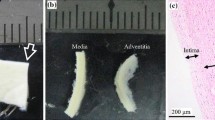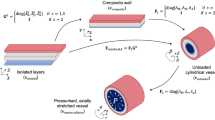Abstract
This study addressed layer-specific differences in the biomechanical response of ascending aortic aneusysms, obtained from patients during graft replacement. Tensile tests were conducted on pairs of (orthogonally directed) intimal, medial, and adventitial strips from the anterior, posterior, and two lateral quadrants. The experimental data were reduced by the Fung-type model, affording appropriate characterization of the material properties. Testing of individual layers beyond rupture disclosed their failure properties, namely their capacity to bear varying deformation and stress levels. Material parameters \( c_{\theta \theta } \) and \( c_{zz} \), specifying circumferential and longitudinal stiffness, received the highest values in the adventitia or intima and the smallest in the media, with \( c_{\theta \theta } \) > \( c_{zz} \) in every layer but the intima. Similar extensibility at failure was found among layers, whereas the adventitia was the strongest of all. Circumferentially and longitudinally directed strips from each layer did not show uniform material parameters and failure properties among regions, but most differences did not reach significance. Medial and adventitial but not intimal layers were stronger circumferentially than longitudinally. This is the first study to place emphasis on the biomechanical properties of the distinct layers of human aneurysmal aorta that may be expected to shed light into the mechanisms promoting aneurysm dissection and rupture.





Similar content being viewed by others
References
Atienza Riera JM, Rojo Pérez FJ, Claes E et al (2010) Influencia de la edad y los aneurismas en la rotura de la pared aorta ascendente. XXVII Encuentro del Grupo Español de Fractura, Oporto, Portugal
Butcher HR Jr (1960) The elastic properties of human aortic intima, media, and adventitia: the initial effect of thromboendarterectomy. Ann Surg 151:480–489
Choudhury N, Bouchot O, Rouleau L et al (2009) Local mechanical and structural properties of healthy and diseased human ascending aorta tissue. Cardiovasc Pathol 18:83–91
Clouse WD, Hallett JW Jr, Schaff HV et al (2004) Acute aortic dissection: population-based incidence compared with degenerative aortic aneurysm rupture. Mayo Clin Proc 79:176–180
Davies RR, Goldstein LJ, Coady MA et al (2002) Yearly rupture or dissection rates for thoracic aortic aneurysms: simple prediction based on size. Ann Thorac Surg 73:17–27
Dzau VJ, Creager MA (2005) Diseases of the aorta. In: Kasper DL, Fauci AS, Longo DL, Braunwald E, Huser SL, Jameson JL (eds) Harrison’s principles of internal medicine, 16th edn. McGraw-Hill, New York
Ferruzzi J, Vorp DA, Humphrey JD (2011) On constitutive descriptors of the biaxial mechanical behaviour of human abdominal aorta and aneurysms. J R Soc Interface 8:435–450
Fung YC, Fronek K, Patitucci P (1979) Pseudoelasticity of arteries and the choice of its mathematical expression. Am J Physiol 237:H620–H631
Holzapfel GA, Sommer G, Gasser CT et al (2005) Determination of layer-specific mechanical properties of human coronary arteries with nonatherosclerotic intimal thickening and related constitutive modeling. Am J Physiol-Heart Circ Physiol 289:H2048–H2058
Holzapfel GA, Sommer G, Auer M et al (2007) Layer-specific 3D residual deformations of human aortas with non-atherosclerotic intimal thickening. Ann Biomed Eng 35:530–545
Iliopoulos DC, Deveja RP, Kritharis EP et al (2009) Regional and directional variations in the mechanical properties of ascending thoracic aortic aneurysms. Med Eng Phys 31:1–9
Iliopoulos DC, Kritharis EP, Giagini AT et al (2009) Ascending thoracic aortic aneurysms are associated with compositional remodeling and vessel stiffening but not weakening in age-matched subjects. J Thorac Cardiovasc Surg 137:101–109
Matsumoto T, Fukui T, Tanaka T et al (2009) Biaxial tensile properties of thoracic aortic aneurysm tissues. J Biomech Sci Eng 4:518–529
Okamoto RJ, Wagenseil JE, DeLong WR et al (2002) Mechanical properties of dilated human ascending aorta. Ann Biomed Eng 30:624–635
Phillippi JA, Pasta S, Vorp DA (2011) Biomechanics and pathobiology of aortic aneurysms. In: Studies in mechanobiology, tissue engineering and biomaterials, vol 7, pp 67–118
Robicsek F, Thubrikar MJ (1994) Hemodynamic considerations regarding the mechanism and prevention of aortic dissection. Ann Thorac Surg 58:1247–1253
Sokolis DP (2010) Strain–energy function and three-dimensional stress distribution in esophageal biomechanics. J Biomech 43:2753–2764
Sokolis DP, Kritharis EP, Giagini AT et al (2012) Biomechanical response of ascending thoracic aortic aneurysms: association with structural remodeling. Comput Methods Biomech Biomed Eng 15:231–248
Svensson LG, Crawford ES (1997) Cardiovascular and vascular disease of the aorta. WB Saunders Company, Philadelphia
Theocaris PS, Sokolis DP (2000) Invariant elastic constants and eigentensors of orthorhombic, tetragonal, hexagonal and cubic crystalline media. Acta Crystallogr A 56:319–331
Vito RP, Demiray H (1982) A two-layered model for arterial wall mechanics. In: Proceedings of the 35th Annual Conference on Engineering in Medicine and Biology
von Maltzahn WW, Warriyar RG, Keitzer WF (1984) Experimental measurements of elastic properties of media and adventitia of bovine carotid arteries. J Biomech 17:839–847
Vorp DA, Schiro BJ, Ehrlich MP et al (2003) Effect of aneurysm on the tensile strength and biomechanical behaviour of the ascending thoracic aorta. Ann Thorac Surg 75:1210–1214
Vorp DA (2007) Biomechanics of abdominal aortic aneurysm. J Βiomech 40:1887–1902
Author information
Authors and Affiliations
Corresponding author
Electronic supplementary material
Below is the link to the electronic supplementary material.
Rights and permissions
About this article
Cite this article
Sokolis, D.P., Kritharis, E.P. & Iliopoulos, D.C. Effect of layer heterogeneity on the biomechanical properties of ascending thoracic aortic aneurysms. Med Biol Eng Comput 50, 1227–1237 (2012). https://doi.org/10.1007/s11517-012-0949-x
Received:
Accepted:
Published:
Issue Date:
DOI: https://doi.org/10.1007/s11517-012-0949-x




